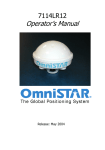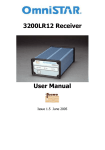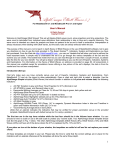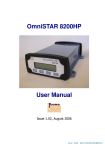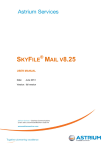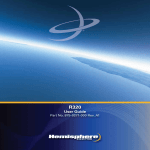Download OmniSTAR 8400HP User Manual
Transcript
OmniSTAR 8400HP User Manual Issue 2.2, Jan 2006 OmniSTAR 8400HP User Manual Notice to Customers This manual has been produced to ensure the very best performance from your OmniSTAR receiver. The manual has been clearly set out with simple instructions to ensure trouble free usage of your OmniSTAR receiver. This publication could contain technical inaccuracies or typographical errors. Changes are periodically made to the information herein; these changes will be incorporated in new editions of the manual. Should you require further assistance please contact your local dealer or the OmniSTAR B.V. office. OmniSTAR Customer Support and 24-Hour Help Line The Netherlands: OmniSTAR B.V. Dillenburgsingel 69 2263 HW Leidschendam The Netherlands Tel: +31 70 31 70 900 Fax: +31 70 31 70 919 Web: www.omnistar.nl E-Mail: [email protected] Australia: OmniSTAR Pty Ltd Tel: +61 8 9322 5295 Fax: +61 8 9322 4164 Web: www.omnistar.com.au E-Mail: [email protected] South Africa: OmniSTAR Pty Ltd Tel: +27 11 315 0420 Fax: + 27 11 312 1774 Web: www.omnistar.co.za E-Mail: [email protected] Singapore: Fugro OmniSTAR Pte Ltd Tel: +65 6542 5001 Fax: +65 6542 2208 E-Mail: [email protected] USA: OmniSTAR Inc. Tel: +1 713 785 5850 Fax: +1 713 785 5164 Web: www.omnistar.com E-Mail: [email protected] ii Issue 2.2, 07/05 OmniSTAR 8400HP User Manual One-Year Limited Hardware Warranty OmniSTAR B.V and its operating companies world-wide (OmniSTAR), warrants this product to be free from defects in workmanship and material for a period of one year from the date of original sale by OmniSTAR or its authorised dealers, to the original purchaser or end user. OmniSTAR reserves the right to repair and/or replace, at its option, any part or parts found to be defective, provided such defects, in their opinion, are due to faulty material or workmanship and are not caused by unauthorised or improper repair or abuse, or normal wear. Purchaser shall be responsible for shipping and insurance of the returned product for repair under this warranty. OmniSTAR will pay shipping and insurance for the product's return to purchaser provided that the product returned proves to be defective under this limited warranty. This warranty applies only to normal usage of the product. It does not apply to units or electronic circuit boards defective due to improper installation or handling. Physical damage due to lightning or other electrical discharge and units subjected to fresh or salt-water contamination are not covered. OmniSTAR reserves the right not to warrant the product if, upon request, sufficient proof of recommended installation compliance as laid out in this manual is not provided. No other warranties are expressed or implied. No other warranties exist. OmniSTAR assumes no responsibility for any consequential or incidental losses or damages of any nature with respect to the use of this product. Issue 0 Issue 1 Issue 2 Issue 2.1 Issue 2.2 Issue 2.21 REVISION HISTORY December 2004 Draft December 2004 Rx initial setup June 2005 Firmware version p1 July 2005 Change baud rate, Ref. station list update Aug 2005 Textual changes Jan 2005 Minor change Manual Reference: OmniSTAR 8400HP User Manual iii Issue 2.2, 07/05 OmniSTAR 8400HP User Manual Copyright OmniSTAR B.V. 2005. No part of this manual can be reproduced without the expressed permission of OmniSTAR B.V. iv Issue 2.2, 07/05 OmniSTAR 8400HP User Manual TABLE OF CONTENTS INTRODUCTION ............................................................................................. 1 ABOUT THIS MANUAL ..................................................................................... 1 SYSTEM FEATURES ........................................................................................ 1 RECEIVER FEATURES ..................................................................................... 1 Housing .................................................................................................... 2 Interfaces ................................................................................................. 2 INSTALLATION AND SET UP ........................................................................ 4 INSTALLATION CONSIDERATIONS ..................................................................... 4 COUNTER ELECTROMAGNETIC FORCE (CEMF) ................................................ 5 CABLE INSTALLATION ..................................................................................... 6 ADDITIONAL FEATURES AND INFORMATION ....................................................... 7 Sleep Mode .............................................................................................. 7 Zero Power Mode ..................................................................................... 7 Status Indicators....................................................................................... 7 Clear NVRAM........................................................................................... 9 ANTENNA LOCATION ..................................................................................... 10 POWER SUPPLY REQUIREMENTS .................................................................. 10 OPERATING CONSIDERATIONS................................................................. 11 NUMBER OF VISIBLE SATELLITES .................................................................... 11 MULTIPATH .................................................................................................. 11 POSITION DILUTION OF PRECISION (PDOP) ................................................... 12 SATELLITE ELEVATIONS ................................................................................ 12 DIFFERENTIAL CORRECTIONS ........................................................................ 12 OPERATION ................................................................................................. 13 COMMUNICATIONS WITH THE RECEIVER ......................................................... 13 Serial Port Default Settings..................................................................... 13 GETTING STARTED ....................................................................................... 14 INITIAL SETUP .............................................................................................. 14 8400HP RECEIVER SETTINGS ....................................................................... 24 OMNISTAR VBS POSITION ........................................................................... 26 SET SEED POINT ......................................................................................... 31 TERMINAL MODE .......................................................................................... 33 8400RTK.................................................................................................... 34 APPENDIX A................................................................................................. 35 TECHNICAL SPECIFICATIONS ......................................................................... 35 PERFORMANCE.................................................................................... 35 ENVIRONMENTAL................................................................................. 35 POWER REQUIREMENTS .................................................................... 35 RF INPUT / LNA POWER OUTPUT ....................................................... 35 INPUT / OUTPUT DATA INTERFACE ................................................... 36 Input / Output Connectors....................................................................... 36 Physical.................................................................................................. 36 v Issue 2.2, 07/05 OmniSTAR 8400HP User Manual Port Pin-Outs.......................................................................................... 36 Power Connector.................................................................................... 36 Serial RS232 Connector ......................................................................... 37 CABLES ....................................................................................................... 38 Power Cable ........................................................................................... 38 RS232 Serial Cable ................................................................................ 38 APPENDIX B................................................................................................. 39 COMMANDS ................................................................................................. 39 Bulb commands...................................................................................... 39 set,...................................................................................................... 39 print,... ............................................................................................ 42 embulb,... ....................................................................................... 44 dmbulb,... ....................................................................................... 45 OmniStar commands.............................................................................. 46 set,...................................................................................................... 46 print,... ............................................................................................ 51 Default parameters ................................................................................. 55 Bulb parameters.................................................................................. 55 OmniStar parameters.......................................................................... 55 APPENDIX C................................................................................................. 56 NMEA 0183 MESSAGE OPTIONS .................................................................. 56 NMEA 0183 MESSAGE FORMATS ................................................................. 57 ALM – GPS Almanac Data ............................................................... 57 GGA – GPS Fix Data ........................................................................ 58 GLL – Geographic Position – Latitude/Longitude ............................. 59 GRS – GPS Range Residuals........................................................... 59 GSA – GPS DOP and Active Satellites ............................................. 60 GST – GPS Pseudorange Noise Statistics ....................................... 61 GSV – GPS Satellites in View........................................................... 62 RMC – Recommended Minimum Specific GPS Data ........................ 63 VTG – Course Over Ground and Ground Speed............................... 64 ZDA – Time and Date....................................................................... 65 APPENDIX D................................................................................................. 66 ACRONYMS USED IN THIS MANUAL ................................................................. 66 APPENDIX E................................................................................................. 67 LIST OF COMMUNICATION SATELLITES ............................................................ 67 APPENDIX F ................................................................................................. 69 LIST OF REFERENCE STATIONS ...................................................................... 69 APPENDIX G ................................................................................................ 73 RECEIVER SERVICE PROCEDURE .................................................................. 73 APPENDIX H................................................................................................. 74 vi Issue 2.2, 07/05 OmniSTAR 8400HP User Manual OMNISTAR RECEIVER PROBLEM REPORT FORM ........................................... 74 USER NOTES ............................................................................................... 75 LIST OF FIGURES Figure 1: 8400HP back side ............................................................................ 3 Figure 2: Zener Diode Connected.................................................................... 5 Figure 3: Multipath......................................................................................... 12 Figure 4: View8400 start screen .................................................................... 15 Figure 5: View8400 Menu File option Connect............................................... 15 Figure 6: View8400 Select Com Port ............................................................. 16 Figure 7: View8400 receiver status................................................................ 16 Figure 8: View8400 DGPS Correction Satellite Status................................... 17 Figure 9: View8400 Configuration menu option DGPS service ...................... 17 Figure 10: View8400 Configuration menu option DGPS service .................... 18 Figure 11: View8400 Subscription details ...................................................... 19 Figure 12: View8400 Firmware Version ......................................................... 20 Figure 13: View8400 GPS Satellites .............................................................. 21 Figure 14: View8400 Position ........................................................................ 22 Figure 15: View8400 Select HP Port NMEA output in Configuration menu .... 22 Figure 16: View8400 NMEA output on HP Port.............................................. 23 Figure 17: View8400 Select HP receiver settings .......................................... 24 Figure 18: View8400 HP parameter............................................................... 24 Figure 19: View8400 GPS receiver settings................................................... 26 Figure 20: View8400 Please switch to receiver port A ................................... 26 Figure 21: View8400 GPS receiver settings................................................... 27 Figure 22: View8400 GPS receiver options ................................................... 28 Figure 23: View8400 Please switch back to the HP port ................................ 29 Figure 24: View8400 select Port NMEA output .............................................. 29 Figure 25: View8400 Port A NMEA output ..................................................... 30 Figure 26: View8400 Select Set Seed Point .................................................. 31 Figure 27: View8400 Set Seed Point ............................................................. 32 Figure 28: View8400 Select terminal Mode.................................................... 33 Figure 29: View8400 Terminal ....................................................................... 33 Figure 30: power Connector .......................................................................... 37 Figure 31: Serial RS232 Connector ............................................................... 37 Figure 32: Reference stations and coverage area for EA-SAT and AF-SAT. . 67 Figure 33: Reference Stations and coverage area for AM-SAT and AP-SAT. 67 Figure 34: Reference stations and coverage area for OPTUS and MSV-ECW. ............................................................................................................... 68 LIST OF TABLES Table 1: 8400HP Connectors........................................................................... 3 Table 2: 8400HP LED indicators...................................................................... 3 Table 3: Power connector Specification......................................................... 37 Table 4: RS232 Connector Specification ....................................................... 38 Table 5: NMEA 0183 messages available for the 8400HP............................. 56 Table 6: Description of the ALM message. .................................................... 57 Table 7: Description of the GGA message..................................................... 58 vii Issue 2.2, 07/05 OmniSTAR 8400HP User Manual Table 8: Description of the GLL message...................................................... 59 Table 9: Description of the GRS message..................................................... 59 Table 10: Description of the GSA message. .................................................. 60 Table 11: Description of the GST message. .................................................. 61 Table 12: Description of the GSV message. .................................................. 62 Table 13: Description of the RMC message. ................................................. 63 Table 14: Description of the VTG message. ................................................. 64 Table 15: Description of the ZDA message. .................................................. 65 Table 16: World-wide satellite frequencies and baud rates ............................ 67 Table 17: Reference stations on EA-SAT ...................................................... 69 Table 18: Reference stations on AF-SAT ...................................................... 70 Table 19: Reference stations on AP-Sat........................................................ 70 Table 20: Reference stations on AM-Sat ....................................................... 71 viii Issue 2.2, 07/05 OmniSTAR 8400HP User Manual Introduction About This Manual This manual has been produced to assist the typical user with the installation and operation of the OmniSTAR 8400HP DGPS Receiver. System Features The OmniSTAR 8400HP DGPS Receiver is part of the Fugro worldwide DGPS Service. The Fugro service is a full-time differential GPS (DGPS) broadcast system, delivering corrections from an array of GPS reference stations located around the globe. Reference stations provide industry standard formatted corrections to Network Control Centres (NCC’s) at strategic geographic locations, where the corrections are decoded, checked, and repackaged in a highly efficient format for broadcast. The data is modulated onto a RF carrier that is then uplinked to an L-band communications satellite. The signals are received at the user's location by an antenna, demodulated by a receiver, and are made available, after selection of the desired individual reference site's data set, as corrections for use in a GPS, differential-capable, receiver. The OmniSTAR 8400HP series of receivers support the following OmniSTAR® services: HP, this is the High Performance service where dual frequency GPS carrier phase measurements are used in an intelligent and innovative way to create wide area positioning results of decimetre accuracy and performance. XP, this is the High Performance service where dual frequency GPS carrier phase measurements are used with precise orbit and precise clock information from the satellite. For XP no Ground reference stations are needed HPXP, Here the solution of HP and XP are merged to optimize performance and redundancy VBS, this is the Virtual Base Station service where single frequency GPS code phase measurements are used to create RTCM corrections data optimised for the users current position. Receiver Features The OmniSTAR 8400HP receiver has the following features: • 20 channel GPS L1/L2 C/A and P-Code Carrier 1 Issue 2.1, 07/05 OmniSTAR 8400HP User Manual • • • Fast GPS reacquisition Fully field-upgradeable firmware Low power consumption The following options are available for the 8400HP: • • • • • • • • L1 plus OmniSTAR VBS L1/L2 plus OmniSTAR HP L1/L2 plus RTK Note: Not supported by Omnistar. 5 Hz RAW data and position output rates 10 Hz RAW data and position output rates Internal Memory Advanced Multipath reduction, GPS L1 Advanced Multipath reduction, GPS L1+L2 Housing The 8400HP receiver is 159 mm wide, 172 mm deep, 88 mm high, and weighs 1.4 kg (Figure 1). The casing allocates space for two non-removable, on-board Li-Ion batteries, a power board, and two Euro cards. One of those cards is the GPS L1 receiver and the other is the OmniSTAR receiver. The enclosure offers protection against environmental conditions and RF interference. In addition, it provides an easy-to-use interface to the GPS card’s data, power and status signals and a rugged, water, shock and vibration resistant housing for outdoor applications. Interfaces The 8400HP provides the following interfaces: • • • • 2 serial ports with LEMO-brand connectors GPS antenna and power port LED indicators to provide status information 2 Internal batteries Accessories The following accessories are included with the 8400HP: • • • • • 1 power adapter cable 1 straight serial port cable GPS antenna Antenna mounting bracket A CD containing PC utilities and product documentation 2 Issue 2.1, 07/05 OmniSTAR 8400HP User Manual For technical specifications on the 8400HP, please see Appendix B. Figure 1: 8400HP back side Connector Function PWR Power connector A GPS serial port connector HP HP serial port connector GPS ANT GPS/L-band antenna connector Table 1: 8400HP Connectors LED STAT REC BATT RX “Blue” Function Status, # GPS satellite tracked Data recording indicator Battery charge and power source OmniSTAR Satellite lock indicator Bluetooth indicator Table 2: 8400HP LED indicators 3 Issue 2.1, 07/05 OmniSTAR 8400HP User Manual Installation and Set Up Installation Considerations Before commencing installation of the OmniSTAR 8400HP in a vehicle or aircraft, the following should be considered: • Determine the preferred location for the unit. Consider cable length, connector attachment space (cable bend radius), stowing excess cable, moisture, chemical corrosion, vibration and heat exposure. • Before drilling holes, consider using existing hardware and locations where equipment was previously installed. Avoid drilling holes that may damage other equipment (e.g. structural frame members, electrical cables or fluid lines). • High vibration and high temperature locations should be avoided whenever possible. • In applications where vibration exceeds 5Gs acceleration, shock mounts are required. (Refer to Customer support for mounting recommendations). • Vehicle primary power has voltages that may be harmful to personnel and equipment. Disconnect the battery cable from the battery –ve (negative) terminal before making connection to any power terminal within the vehicle. 4 Issue 2.1, 07/05 OmniSTAR 8400HP User Manual Counter Electromagnetic Force (CEMF) A potential problem inherent in any installation of electronic systems within a vehicle is Counter Electro-magnetic Force (CEMF). CEMF is caused when relays or solenoids, connected to the vehicle DC power distribution, are de-energised. The voltage produced may exceed – 400 volts. CEMF is produced by equipment such as the following: • Electric fan brakes • Air conditioners • Starter relays • Electric pump relays CEMF is more than sufficient to damage or cause erratic operation of any electronic system that is also connected to the same vehicle DC power supply. CEMF can be eliminated by installing diodes at the relays and solenoids that cause the problem, and more importantly at the power supply cable connections on the receiver. A 47V, 5W, Zener diode (1N5368 or equivalent) should be connected between the receiver +ve (positive) power input terminal and ground, as illustrated in Figure 2. Battery +ve (positive) supply Ground Zener Diode Figure 2: Zener Diode Connected 5 Issue 2.1, 07/05 OmniSTAR 8400HP User Manual Cable Installation Cables must be correctly installed for optimum system operation. Therefore, the following should be noted: • Do not route an L-Band receiver remote antenna cable with the cabling of any other radio system. This may cause interference between both systems. • If at all possible, do not run L-Band receiver antenna cables parallel to other radio system cabling closer than 30 centimetres. • If cables must cross, ensure that they cross at an angle of 90°. This minimises the possibility of interference. • As far as is practicable, ensure that cables and I/O connectors are unique and fit only in their allocated location. • Avoid routing cables along-side power generator cabling and other high electrical noise sources. This can cause interference. • Do not kink or force cables into sharp bends that may damage the cables and cause system failure. • After installation, ensure that excess cable is looped and clamped or tied safely away from any control cables, fuel lines, hydraulic lines or moving parts. • When stowing over length cables, 150 mm minimum cable bend radius. • Cable routing must (e.g. exhaust manifold). avoid form high loops not temperature less exposure 6 Issue 2.1, 07/05 than OmniSTAR 8400HP User Manual Additional Features and Information This section contains information on the additional features of the 8400HP receiver and an explanation of the Led functions. Sleep Mode In sleep mode, the power board and Bluetooth module will continue to draw power from the batteries, causing the batteries to drain over time. Follow these steps to put the 8400HP into sleep mode: 1. 2. 3. Turn on your receiver. Press and hold the receiver’s power key for more than four seconds and less than eight seconds. The STAT LED will be orange. The receiver enters Sleep Mode. Any activity on the RS232 port will turn the receiver on. If you press and hold the power key for more than 14 seconds, it will be ignored. This protects receiver operation against stuck keys. Put the receiver in Zero Power Mode to prevent the draining of the battery. Zero Power Mode When your receiver is off, even in Sleep Mode, the power board will continue to draw power from the batteries. This means that if you fully charge your receiver, turn it off and store it, the receiver will drain its battery power in less than two months. To stop the power board from draining the batteries, you can put your receiver in Zero Power Mode: 1. Turn on your receiver. 2. Press and hold the power key for more than 8 seconds, but less than 14 seconds. 3. Release the power key when the STAT and REC LED''s all become red. When the LED's turn off, your receiver will be in Zero Power Mode. 4. Press the Reset key for about one second to return to Normal mode. When the internal batteries have completely discharged and no external power is connected, the receiver will go into Zero Power Mode automatically to prevent the batteries from over discharging. Status Indicators The 8400HP has LED indicators that provide the status of the 8400HP. See Table 2: 8400HP LED indicators on page 3. 7 Issue 2.1, 07/05 OmniSTAR 8400HP User Manual Status LED • When the receiver is on and no GPS satellites are tracked, the STAT LED will blink red. • When satellites are tracked, the STAT LED will produce one green blink for each tracked satellite. Record LED and FN Key • During the first second of pressing the FN key, the REC LED is orange. • Pressing and holding the FN key for more than five and less than eight seconds will turn the baud rate of serial port A to 9600. After about five seconds of pressing the FN key, the REC LED becomes red. Release the FN key while the REC LED is red (during the next three seconds). • Pressing and holding the FN key for more than eight seconds has no impact. • After loading new firmware or clearing the receiver’s NVRAM, the receiver checks its internal file system. During this operation, the REC LED flashes orange, and the file system is not accessible for CDU (control display unit) applications or for data recording. This operation may require from fractions of a second to several minutes, depending on the circumstances and the amount of internal memory. Bluetooth LED The colour of the BT LED indicates the level of activity at the Bluetooth communication link: • Blue flashes – the Bluetooth module is on but no connection is established. • Solid blue light – the Bluetooth module is on and a connection is established. • No light – the Bluetooth module is off If no Bluetooth module is installed the LED will flash when Blue tooth is switched on. Battery LED The colour of the BATT LED indicates the level of internal battery charge in the receiver: • Green – indicates greater than 85% charge • Orange – indicates an intermediate charge • Red – indicates less than 15% charge The pattern of blinks of the BATT LED also indicates the source of power: • Solid light – an external power supply is used and the batteries are not being charged. • Blinking once a second – the batteries are being charged. 8 Issue 2.1, 07/05 OmniSTAR 8400HP User Manual • • Blinking once every five seconds – the receiver uses the internal batteries for power. Not blinking – the receiver is in Zero Power Mode or the internal batteries are completely discharged and no external power is connected. When the internal batteries have completely discharged and no external power is connected, the receiver will go into Zero Power Mode to prevent the batteries from over discharging. RX LED The colour of the RX LED indicates the status of the differential corrections for the OmniSTAR board. For the OmniSTAR board when in operation mode: • Blinks green – the receiver is searching for the selected OmniSTAR satellite. Solid green – the OmniSTAR satellite is locked. Clear NVRAM The receiver’s Non-Volatile Random Access Memory (NVRAM) holds data required for satellite tracking, such as ephemeris data and receiver position. The NVRAM also keeps the current receiver’s settings, such as active antenna input, elevation masks and recording interval, and information about the receiver’s internal file system. Even though clearing the NVRAM is not a common (nor normally a recommended) operation, there are times when clearing the NVRAM can eliminate communication or tracking problems. Clearing the NVRAM in your receiver can be interpreted as a “soft boot” in your computer. After clearing the NVRAM, your receiver will require some time to collect new ephemeris and almanacs (around 15 minutes). Clearing the NVRAM of your receiver will not delete any files already recorded in your 8400HP’s memory. However, it will reset your receiver to factory default values. In addition, the NVRAM keeps information about the receiver file system. Note that after clearing the NVRAM, the receiver's STAT LED will flash orange for a few seconds indicating that the receiver is scanning and checking the file system. Use Keys to Clear NVRAM 1. Press the power key to turn off the receiver. 2. Press and hold the FN key. 3. Press and hold the power key for about one second. Release the power key while continuing to hold the FN key. 4. Wait until the STAT and REC LED’s are green 9 Issue 2.1, 07/05 OmniSTAR 8400HP User Manual 5. 6. Wait until the STAT and REC LED’s blink orange. Release the FN key while the STAT and REC LED’s blink orange. Use View8400 to clear NVRAM 1. Connect the receiver to a computer via the HP port 2. Select in the Configuration menu the GPS receiver settings 3. Change cable from port HP to port A 4. Press Clear NVRAM button Antenna Location Antenna positioning is critical to system performance. The following conditions must be met for optimum system performance: • Antenna must be mounted at least 1.5 metres away from transmitting antennas of any frequency. Closer positioning may cause saturation of receiver RF circuits. • The antenna should be mounted at the highest practical point that will give a good view of the horizon and be as near level as possible. • The antenna must be located along the vehicle centre-line, or at a relevant reference point on the vehicle. Power Supply Requirements The 8400HP contains an internal power board that manages receiver power and battery charging, and is connected to the receiver board and the batteries. The power board receives power from the internal batteries, even when the receiver is turned off. This feature allows the internal batteries to charge, regardless of the receiver’s status (on or off). To prevent the batteries from discharging when the receiver is stored, put the receiver in Zero Power Mode. A tightly regulated input supply to the 8400HP is not required, as long as it falls within the input range +8 to +28VDC. If the voltage supplied is below the minimum specification, the receiver will suspend operation. If the voltage supplied is above the maximum specification, the receiver may be permanently damaged, voiding your warranty. 10 Issue 2.1, 07/05 OmniSTAR 8400HP User Manual Operating considerations The 8400HP is a high-quality positioning device. The accuracy that the user can obtain depends on several factors, including: • • • • • • Number of visible satellites Multipath Dilution of Precision (DOP) Satellite elevations Differential correction Distance to reference station network Number of visible satellites A minimum of four satellites is required to calculate a 3-dimensional position. In general it can be said that every increase in the number of visible satellites will result in an increase in the system’s accuracy. As the GPS satellites orbit around the earth the number of visible satellites will change in time. The GPS constellation has been designed so as to provide a minimum of 4 visible satellites at any location at all times. The number of visible satellites can decrease due to blockage by objects such as trees and buildings. Multipath It is possible for satellite signals to reflect off large nearby objects such as buildings, cars or even the ground, thereby resulting in an erroneous distance measurement. This phenomenon is known as multipath. Multipath can cause significant errors in the position determination and it is therefore important to place the receiver in an environment, which is free of large reflective surfaces. It is also recommended to mount the receiver directly onto a surface, while maintaining a clear view of the sky in all directions. 11 Issue 2.1, 07/05 OmniSTAR 8400HP User Manual Figure 3: Multipath Position Dilution of Precision (PDOP) The Position Dilution of Precision (PDOP) is a measure of the satellite geometry. The lower the PDOP value, the more accurate the GPS position will be. Satellite elevations The signal from a satellite that is low on the horizon will travel a greater distance through the atmosphere. This results in a lower signal strength and a delayed reception, thereby causing erroneous and noisy data. By default the 8400HP is configured to ignore any satellites that have an elevation angle lower than 5° for VBS and lower than 8° for HP. Differential corrections For accurate positioning it is essential that the differential corrections are received. In order to ensure reception of the OmniSTAR satellite signal the line of sight towards the satellite must not be blocked by objects such as trees and buildings. Multipath reflections can cause destructive interference, thereby significantly decreasing the signal strength. It is therefore recommended to mount the 8400HP antenna directly onto a surface in a reflection free environment. Although the 8400HP has been designed to provide optimal system performance under most circumstances, it is possible, due to the nature of radio communications that the system performance degrades due to local interference sources. 12 Issue 2.1, 07/05 OmniSTAR 8400HP User Manual Operation Before operating the receiver for the first time, ensure that you have followed the installation instructions. Communications with the Receiver Communication with the receiver is straightforward, and consist of issuing commands through the communications ports from an external serial communication device. This could be either a terminal or an IBM-compatible PC that is directly connected to the receiver serial port. For more information about commands and logs that are useful for basic operation of the receiver, go to Appendix D. Serial Port Default Settings The receiver communicates with your PC or Terminal via serial port. For communication to occur, both the receiver and the operator interface have to be configured properly. The receiver’s port A and HP port default settings are as follows: • 115200 BPS, no parity, 8 data bits, 1 stop bit, no handshaking. The data transfer rate you choose will determine how fast information is transmitted. Take for example a log whose message byte count is 96. The default port settings will allow 10 bits/byte. It will therefore take 960 bits per message. To get 10 messages per second then will require 9600 BPS. Please also remember that even if you set the bps to 9600 the actual data transfer rate will be less and depends on the number of satellites being tracked, filters in use, and idle time. It is therefore suggested that you leave yourself a margin when choosing a data rate. 13 Issue 2.1, 07/05 OmniSTAR 8400HP User Manual Getting Started The purpose of this section is to get you started with the 8400HP as quickly as possible. The guide will address receiving the satellite data carrier, and then checking the functionality and status of the HP Process. Generally when the receiver is supplied to you it will be configured for the mode and data link(s) you have subscribed to. In most cases to get up and running will be a case of connecting the appropriate cables and applying power to the system. Included with your receiver is the View8400 application. This application allows you to check the status of the receiver and configure the GPS and HP receiver. Initial Setup Refer to the following diagrams, as you will need to assemble all the required items. • • • • • OmniSTAR 8400HP Receiver GPS/L-band Antenna Antenna Cable Power Cable HP Port Cable 1. Install the antenna where it has a clear view of the sky in the direction of the satellite. 2. Connect the antenna cable between the antenna and the 8400HP (TNC connector labelled ‘GPS ANT’). 3. Connect the power cable to a suitable 8-28 VDC power source. 4. Turn on the receiver: press and hold the green power button for about 0.5 seconds and release it. 5. Check the colour of the BATT LED to verify the receiver has sufficient power. 6. Connect the receiver to the serial port of a computer via the HP port and start the View8400.exe application. View8400 is available on the supplied CD or on the www.omnistar.nl website. The following screen will appear, Figure 4: View8400 start screen. 14 Issue 2.1, 07/05 OmniSTAR 8400HP User Manual Figure 4: View8400 start screen 7. Select File and Connect. Figure 5: View8400 Menu File option Connect The Select Com port screen enables you to select the COM port of the computer and select a different baud rate, Figure 6: View8400 Select Com Port. The 8400HP receiver uses two ports port A for the GPS and the HP port for the HP processor. The ‘use two comports’ selection box can be used if both ports are connected to the computer. When the ‘Autoconnect’ option is ticked the application will use the same settings next time the application is started. If the Autoconnect option was used before and the receiver is on a different COM port, please use disconnect in the File menu option and connect to get the Select Com port window. 15 Issue 2.1, 07/05 OmniSTAR 8400HP User Manual Figure 6: View8400 Select Com Port When the connection is established the View8400 screen will show the current status of the receiver. Figure 7: View8400 receiver status 16 Issue 2.1, 07/05 OmniSTAR 8400HP User Manual The separate information blocks are: • DGPS Correction Satellite Status (Figure 8) • Subscription details (Figure 11) • Firmware version (Figure 12) • GPS Satellites (Figure 13) • Position (Figure 14) Figure 8: View8400 DGPS Correction Satellite Status The OmniSTAR 8400HP receiver is configured for the area of work. For Europe this is the EA-Sat with frequency 1535.1525 MHz. The DGPS Correction Satellite Status window will show the current status of the satellite link. Appendix E contains a list of OmniSTAR Satellites. If the receiver is used in a different area of the world a different satellite must be selected. 8. Selecting ‘DGPS service’ in the menu option ‘Configuration’ opens the Select DGPS service window. Figure 9: View8400 Configuration menu option DGPS service 17 Issue 2.1, 07/05 OmniSTAR 8400HP User Manual Figure 10: View8400 Configuration menu option DGPS service 11. In the Satellite selection box all available OmniSTAR satellites can be selected. 12. The receiver is ready to work when the receiver is logged on to the correct satellite signal and the subscription is valid. 13. The Subscription details window (Figure 11) shows the status of both the VBS and the HP subscription. The warnings at the right of the window will show the errors if the subscription does not work. The Needs Update warning is generated when the receiver is switched after a long period of inactivity or after a change of satellite service. The ‘Needs update’ warning will disappear after the receiver has received the OmniSTAR Almanac and site table from the satellite link. 18 Issue 2.1, 07/05 OmniSTAR 8400HP User Manual Figure 11: View8400 Subscription details 14. If one of the other warnings is active you will have to contact the OmniSTAR office for an activation. 19 Issue 2.1, 07/05 OmniSTAR 8400HP User Manual Figure 12: View8400 Firmware Version 15. The OmniSTAR activation is sent by satellite to the receiver, which is identified by the OmniSTAR serial number. 16. The receiver must be switched on and be receiving the satellite signal at the moment the subscription is sent. 17. The GPS Satellites window will show which GPS satellites are tracked and supply all information about the satellites. 20 Issue 2.1, 07/05 OmniSTAR 8400HP User Manual Figure 13: View8400 GPS Satellites 21 Issue 2.1, 07/05 OmniSTAR 8400HP User Manual Figure 14: View8400 Position The position window will show the current position. The tabs can be selected if you want to show the position information in a different format. 18. Enable the NMEA output on the HP port. Select in the Configuration menu option, NMEA output on HP Port. Figure 15: View8400 Select HP Port NMEA output in Configuration menu 19. The following screen will appear. 22 Issue 2.1, 07/05 OmniSTAR 8400HP User Manual Figure 16: View8400 NMEA output on HP Port If any message is switched on at startup of View8400, this message will be ticked and the output rate becomes visible. 20. When View8400 is closed the HP Port output will be as selected in the right figure. 23 Issue 2.1, 07/05 OmniSTAR 8400HP User Manual 8400HP receiver settings In the Configuration menu option HP receiver settings the receiver HP parameter window will appear. Figure 17: View8400 Select HP receiver settings Figure 18: View8400 HP parameter • • • Smooth mode, HP filter options VBS seeding, at start-up the VBS position is used as start position for the HP process. Static initialisation, if the receiver is static this mode will improve the initialisation time. 24 Issue 2.1, 07/05 OmniSTAR 8400HP User Manual • • • Autoscan search mode, the receiver can use the Low and High power OmniSTAR satellites. In high mode the receiver will use the OmniSTAR spotbeams. Frequency search span, the receiver searches for the OmniSTAR satellite signal using the defined span. If an interfering satellite signal is close to the OmniSTAR frequency the receiver can lock on to that frequency. To prevent this the span can be reduced. Engine mode, the receiver can be set to ‘HP or ‘XP’ mode. In ‘HP’ mode the receiver uses the Fugro network of reference stations for the HP positioning. In ‘XP mode the receiver uses the precise orbits which are broadcasted by the OmniSTAR satellites. 25 Issue 2.1, 07/05 OmniSTAR 8400HP User Manual OmniSTAR VBS position The OmniSTAR 8400HP receiver can be configured to output HP corrected GPS positions over the HP port and simultaneously output VBS corrected position through port A. The receiver must have a valid VBS subscription, the View8400 Subscription Details screen (Figure 11, page 19) shows the current status of the subscription. With the option ‘GPS receiver settings…’ in the Configuration menu the GPS receiver can be configured for VBS. Figure 19: View8400 GPS receiver settings If you are using a single COM port, the application will show the following screen. Figure 20: View8400 Please switch to receiver port A The serial cable will have to be disconnected from the HP port and connected to port A. Please press OK after the cable is switched. The GPS receiver settings window shows the current GPS receiver configuration. 26 Issue 2.1, 07/05 OmniSTAR 8400HP User Manual Figure 21: View8400 GPS receiver settings • • • • The Positioning mode can be either standalone or DGPS. The DGPS max age only applies for the VBS position. The Bluetooth option is not available in all 8400HP receivers, if it is not available the selection switches the blue LED off. If you require a NMEA output rate higher than 1 Hz, the Raw update and Position update rate has to be changed to the required interval time. In the GPS receiver options you can check if a higher update rate is available. The receiver options in Figure 22: View8400 GPS receiver options show the maximum update rate of the used receiver, this can be upgraded to 10 hz. With the GPS receiver options button you can request a list of the available receiver options. 27 Issue 2.1, 07/05 OmniSTAR 8400HP User Manual Figure 22: View8400 GPS receiver options The options can be purchased or leased if you want to upgrade your receiver. With the ‘Load’ button the “jpo" upgrade file can be loaded in to the receiver. The upgrade file name contains the internal GPS receiver serial number. This number is necessary if you request a receiver upgrade. The ‘Save’ button will create a text file with all options. The ‘Exit’ button is used to close the window. The options determine the receiver capabilities. For a receiver to work with VBS the Code differential Base and Rover options are necessary. If these options are available you can configure the receiver to output differential corrected positions from port A. After configuring the GPS receiver press OK. Figure 23: View8400 Please switch back to the HP port will appear if you are using a single COM port connection. 28 Issue 2.1, 07/05 OmniSTAR 8400HP User Manual Figure 23: View8400 Please switch back to the HP port Change the serial cable first before pressing ‘OK’, the application does send a configuration command to the HP port after ‘OK’ is pressed. The NMEA output of port A can be selected in the Configuration menu option ‘NMEA output’. Select Port A and connect the serial cable to port A. Figure 24: View8400 select Port NMEA output The Port A output options window will appear and the required NMEA messages can be selected. 29 Issue 2.1, 07/05 OmniSTAR 8400HP User Manual Figure 25: View8400 Port A NMEA output 30 Issue 2.1, 07/05 OmniSTAR 8400HP User Manual Set Seed Point The OmniSTAR HP system has a typical dynamic convergence time of 20 minutes. To improve the convergence time the OmniSTAR HP system can be started from a known position or seed point. Figure 26: View8400 Select Set Seed Point The Set Seed point window will appear, Figure 27: View8400 Set Seed Point. The application will read the current seed point which is stored in the receiver and show the values in the position fields. If the receiver does not have a seed position the fields will be empty. The following options are available, see Figure 27: View8400 Set Seed Point: 1. Send seed point reset 2. Get current position and Std dev 3. Store seed point in file 4. Load seed point from file 1. 2. 3. 4. Send seed point reset will reset the stored seed point in the receiver. Get current position and Std dev, read the current position. Store seed point in file, the position can be stored in a “ksp” “known start position” file. Retrieve the seed position from a “ksp” file. These functions can be used a) b) Want to start work quickly If you want to stop working and continue to work the next day starting at the last point. 31 Issue 2.1, 07/05 OmniSTAR 8400HP User Manual Figure 27: View8400 Set Seed Point 32 Issue 2.1, 07/05 OmniSTAR 8400HP User Manual Terminal Mode The View8400 application has a terminal option that can be used to send commands direct to the HP port of the receiver. Figure 28: View8400 Select terminal Mode Figure 29: View8400 Terminal If you are connected with the receiver using a single COM port, the commands will be sent to the HP port. If you are connected using two COM ports you can select the HP or the GPS port. The terminal can be used to send text files that can contain a series of commands. Appendix B contains a list of the commands. 33 Issue 2.1, 07/05 OmniSTAR 8400HP User Manual 8400RTK The 8400HP receiver can be used as a RTK rover and base station. These options will have to be purchased separately; this can be verified in the GPS receiver options. In the OmniSTAR VBS position paragraph it is shown how the options can be read from the receiver. The 8400RTK base station can output RTCM messages from port A. The commands for this configuration have to be send to Port A: dm %%set,/par/rover/mode/,off %%set,/par/base/mode/,off %%set,/par/pos/mode/cur,sp %%set,/par/ref/pos//geo,{W84,N52d5.7860586m,E4d24.3687564m ,55.782} em,,rtcm{/18:1,/19:1,/20:1,/21:1,/22:1,/3:10} The 8400RTK rover can output the GPS fixed position, GGA quality indicator value ‘4’, from both the HP port and port A. 8400RTK Rover, NMEA from HP Port: dm,/dev/ser/b dm %%set,/par/dev/ser/b/echo,/dev/ser/a 8400RTK Rover NMEA from port A dm dm,/dev/ser/c em,/dev/ser/c,/msg/nmea/GGA em,,/msg/nmea/GGA %%set,/par/pos/mode/cur,pd %%set,/par/dev/ser/a/imode,rtcm The last command sets the port A input mode to RTCM, this means that the receiver does not accept commands anymore. To configure the receiver for HP mode a Clear NVRAM has to be performed using the power and FN key first, see Clear NVRAM on page 9. After this the View8400 can be used to configure the 8400HP receiver. 34 Issue 2.1, 07/05 OmniSTAR 8400HP User Manual Appendix A Technical Specifications PERFORMANCE Position Accuracy 1 GPS satellite Reacquisition Data Rates VBS: 25 cm (X,Y) 50 cm Z HP: Seeding: 5 cm (X,Y) 10 cm Z Static 3D 30cm,10 min Dynamic 3D 30cm 25 min RTK:H: 10 mm + 1ppm V: 15 mm + 1ppm < 1 sec 1 Hz (default), 5, 10, 20 Hz optional ENVIRONMENTAL Operating Temperature -30°C to +60°C with batteries Storage Temperature -40°C to +75°C with batteries Humidity Not to exceed 95% non-condensing POWER REQUIREMENTS Voltage +8 to +28 VDC (for work) +9 to +28 VDC (for charge battery) Minimum Charge current <= 2Amp Power consumption OmniSTAR Mode 5.1 W RF INPUT / LNA POWER OUTPUT Antenna connector TNC female, 50 nominal 1 Typical values. Performance specifications are subject to GPS system characteristics, U.S. DOD operational degradation, ionospheric and tropospheric conditions, satellite geometry, baseline length and multipath effects. 35 Issue 2.1, 07/05 OmniSTAR 8400HP User Manual impedance RF Input Frequencies 1575.42 MHz (L1), 1227.60 MHz (L2), 1525 MHz – 1559 MHz (L-Band) LNA Power +2.7 to +12 VDC; 15 mA @ 5.0 typical INPUT / OUTPUT DATA INTERFACE Electrical Specification Baud Rate RS232 300, 1200, 4800, 9600 19200, 57600, 115200(default) bps Input / Output Connectors GPS ANT TNC female jack, 50 nominal Impedance, + 5.42 VDC (output from 8400HP to antenna/LNA) Physical Size W: 195 x H: 88 x D: 172 mm Weight 1.4 kg Enclosure Aluminium Port Pin-Outs Power Connector The power connector (Figure 30) is a sealed receptacle, 5 pin W.W. Fisher bulkhead plug. Table 3 gives power connector specifications. 36 Issue 2.1, 07/05 OmniSTAR 8400HP User Manual Figure 30: power Connector Number 1 2 3 4 5 Signal Name Power_INP Power_INP Power_GND Power_GND Dir Details P 6 to 28 Volts DC input P 6 to 28 Volts DC input P Ground, power return P Ground, power return Not Used Table 3: Power connector Specification Serial RS232 Connector For ports A and HP. The RS232 connectors (Figure 31) are sealed receptacle, 7 pin W.W. Fisher bulkhead plugs. Figure 31: Serial RS232 Connector 37 Issue 2.1, 07/05 OmniSTAR 8400HP User Manual Table 4 gives the RS232 connector specification. Number Signal Name 1 Power_OUT 2 GND 3 CTS 4 RTS 5 RXD 6 TXD 7 Dir P I O I O Details Power Output (Supplied Voltage) Signal ground Clear to send Request to send Receive data Transmit data Not used Table 4: RS232 Connector Specification Cables Power Cable The power cable supplied with the 8400HP is a 5-pin W.W. Fisher Series 102 plug to 2-way SAE connector. With the power cable a power charger is supplied which can be used as an external power source or as the charger for the internal batteries. This unit converts the alternating current (AC) normally supplied from an electrical outlet to a direct current (DC), which is used to charge the batteries and power the receiver. • Input voltage – between 90 and 264 V AC • Frequency of input power – between 47 Hz and 63 Hz • Output voltage – 12 V DC @ 2.5 A (30 W) RS232 Serial Cable The RS232 serial cable is used to the receiver’s port A or port HP and an external device (hand-held controller or computer). The cable is a sealed DB-9 female plug to a sealed 7-pin W.W. Fisher plug. 38 Issue 2.1, 07/05 OmniSTAR 8400HP User Manual Appendix B Commands Following are the commands with detailed descriptions that can be sent to the 8400HP. COMMANDS FOR HP-BULB RECEIVER { ver 1.0 p1 } ********************************************************** Bulb commands ********************************************************** set,... set,/par/bulb/init/fctr,mode {Set all the parameters to the default factory value} mode: y on yes {}; {}; {}; n {}; off {}; no {}. ---------------------------------------------------------set,/par/bulb/reset,mode mode: y on yes {}; {}; {}; n {}; off {}; no {}. ---------------------------------------------------------- 39 Issue 2.1, 07/05 OmniSTAR 8400HP User Manual set,/par/bulb/conf,param param: off {}; on { automatic configuration of system }. ---------------------------------------------------------set,/par/bulb/mode,param param: off { mode OFF }; omni { mode OmniStar }. ---------------------------------------------------------set,/par/bulb/ant/pwr,mode mode: off { a power of the antenna is turn off }; on { a power of the antenna is turn on }. ---------------------------------------------------------set,/par/bulb/dev/ser/b/rate,param { Serial port Baud Rate } param: 300 {}; 600 {}; 1200 {}; 2400 {}; 4800 {}; 9600 {}; 19200 {}; 38400 {}; 57600 {}; 115200 {}; 153600 {}. ---------------------------------------------------------set,/par/bulb/dev/ser/b/imode,param { Serial port Input Mode } param: cmd { command mode }; jps { JPS messages input mode }; echo { echo mode }. ---------------------------------------------------------- 40 Issue 2.1, 07/05 OmniSTAR 8400HP User Manual set,/par/bulb/dev/ser/b/eoff,string { Ech-off sequence parameter (arbitrary string comprising up to 32 characters) } For example: #BULB# {set,bulb/dev/ser/a/eoff,"#BULB#"} ---------------------------------------------------------set,/par/bulb/dev/ser/b/echo,param { Serial port Echo Mode } param: /dev/null { disable echo mode }; /dev/ser/a { echo in port A }; /dev/ser/b { echo in port B }. ---------------------------------------------------------set,/par/bulb/spectr/spec,mode mode: off { spectrum OFF }; on { spectrum ON }. ---------------------------------------------------------set,/par/bulb/spectr/carrfrq,frequency frequency: in Hz { carrier frequency }. frequency range: Omni: 1525000000 Hz - 1559000000 Hz for example: 1535152500 ---------------------------------------------------------set,/par/bulb/spectr/spanfrq,frequency frequency: in Hz { frequency span }. frequency range: 41 Issue 2.1, 07/05 OmniSTAR 8400HP User Manual 0 Hz - 100000 Hz for example: 100000 ---------------------------------------------------------set,/par/bulb/spectr/filfrq,frequency frequency: in Hz { frequency filter }. frequency range: 0 Hz - 10000 Hz for example: 10000 ---------------------------------------------------------set,/par/bulb/spectr/detnum,number number: {}. number range: 1 - 500 for example: 500 print,... print,/par/bulb:on ---------------------------------------------------------print,/par/bulb/conf:on ---------------------------------------------------------print,/par/bulb/mode:on ---------------------------------------------------------print,/par/bulb/spectr:on 42 Issue 2.1, 07/05 OmniSTAR 8400HP User Manual print,/par/bulb/spectr/param param: spec { spectrum ON/OFF }; carrfrq { carrier frequency }; spanfrq { frequency span }; filfrq { frequency filter }; detnum {}. ---------------------------------------------------------print,/par/bulb/rcv/ver:on print,/par/bulb/rcv/ver/param param: main { firmware version }; boot { boot-loader version }; hw { hardware version }; board { board version }. ---------------------------------------------------------print,/par/bulb/rcv/uptime:on { time since last re-boot: day-hours-minutes-seconds, e.g. 0d01h31m12s }. ---------------------------------------------------------print,/par/bulb/rcv/id:on { receiver ID }. ---------------------------------------------------------print,/par/bulb/rcv/model:on { receiver model }. ---------------------------------------------------------print,/par/bulb/rcv/mem:on { size of RAM in kilobytes }. ---------------------------------------------------------print,/par/bulb/rcv/sn:on ---------------------------------------------------------print,/par/bulb/dev/thermo/out { query receiver board temperature , [Celsius] }. ---------------------------------------------------------- 43 Issue 2.1, 07/05 OmniSTAR 8400HP User Manual print,/par/bulb/dev/ser/a/param print,/par/bulb/dev/ser/b/param param: rate { Serial port Baud Rate }; imode { Serial port Input Mode }; echo { Serial port Echo Mode }; eoff { Echo-off sequence parameter }. ---------------------------------------------------------print,/par/bulb/ant/param param: pwr dc { status of power antenna }; { status of external antenna connection: off - ext antenna will not draw any DC normal - ext antenna draws normal DC overload - ext antenna draws current higher than expected }. ---------------------------------------------------------print,/par/bulb/pwr/param param: extant {query external antenna voltage, [volts] }; extantdc {query external antenna current, [mA] }. ---------------------------------------------------------print,bulb/out/dev/ser/a print,bulb/out/dev/ser/a:on print,bulb/out/dev/ser/b print,bulb/out/dev/ser/b:on { This message set comprises messages enabled for output to the corresponding serial port (only for "jps" and "nmea" messages) }. embulb,... embulb,/dev/ser/b,jps/message message: RT RD { Receiver Time }; { Receiver Date }; 44 Issue 2.1, 07/05 OmniSTAR 8400HP User Manual PG PV DP SI EL AZ EC E1 E2 TC { { { { { { { { { { SS EE ET Geodetic Position }; Cartesian Position and Velocity }; Dilution of Precision (DOP)Parameters }; Satellite Indices }; Satellite Elevations }; Satellite Azimuths }; C/A Carrier to Noise Ratio }; P/L1 Carrier to Noise Ratio }; P/L2 Carrier to Noise Ratio }; Time Since Last Loss-of-Lock on particular C/A signal }; { Satellite navigation status }; { Epoch End }; { Epoch Time }; gt po pg ve pv { { { { { GPS Time << from OmniSTAR HP }; Cartesian Position << from OmniSTAR HP}; Geodetic Position << from OmniSTAR HP}; Cartesian Velocity << from OmniSTAR HP}; Cartesian Position and Velocity << from OmniSTAR HP }; dp { Dilution of Precision (DOP) Parameters << from OmniSTAR HP }; ss { Satellite navigation status << from OmniSTAR HP }; hp { data from OmniSTAR HP }; St { status OmniSTAR VBS and OmniSTAR HP }. ---------------------------------------------------------embulb,/dev/ser/b,/msg/nmea/message message: GGA GSA { Global Positioning System Fix Data }; { GNSS DOP and Active Satellites << from OmniSTAR HP }; GST { GNSS Pseudorange Error Statistics << from OmniSTAR HP }; GSV { GNSS Satellites in Viev }; VTG { Course Over Ground and Ground Speed << from OmniSTAR HP }. ---------------------------------------------------------embulb,/dev/ser/b,/msg/vbs ---------------------------------------------------------- dmbulb,... dmbulb 45 Issue 2.1, 07/05 OmniSTAR 8400HP User Manual dmbulb,/dev/ser/a dmbulb,/dev/ser/b ---------------------------------------------------------********************************************************** OmniStar commands ********************************************************** set,... set,/par/omni/init/fctr,mode { Set OmniStar the parameters to the default factory value. } mode: y on yes {}; {}; {}; n {}; off {}; no {}. ---------------------------------------------------------set,/par/omni/beam/chan,satellite satellite: easat asats amsce amscc amscw optus xsat apsat amsat afsat aorw aore ior por auto chartco user { { { { { { { { { { { { { { { { { EA-SAT (Europe) }; ASAT S.America }; AMSC (N.America) East }; AMSC Central }; AMSC (N.America) West }; Optus Austr./N.Z. }; XSAT Africa/Asia }; AP-Sat (Asia) }; AM-Sat (America) }; AF-Sat (Africa) }; AORW }; AORE }; IOR }; POR }; automatic scan for Fugro }; ChartCo }; user frequency }. 46 Issue 2.1, 07/05 OmniSTAR 8400HP User Manual ---------------------------------------------------------set,/par/omni/beam/cfnom,frequency frequency: in Hz { nominal carrier frequency }. frequency range: 1525000000 Hz - 1559000000 Hz for example: 1535152500 ---------------------------------------------------------set,/par/omni/beam/srnom,symbolRate symbolRate: 609 {}; 1219 {}; 2438 {}; 4876 {}. ---------------------------------------------------------set,/par/omni/beam/serv/sid,xxxx xxxx: in Hexadecimal system { will be used only in "user" mode }. for example: c685 ---------------------------------------------------------set,/par/omni/beam/serv/scrv,xxxx { scrambler vector } xxxx: in Hexadecimal system { will be used only in "user" mode }. for example: 5c08 ---------------------------------------------------------- 47 Issue 2.1, 07/05 OmniSTAR 8400HP User Manual set,/par/omni/beam/srch/span,frequency { search range } frequency: 5 { 5 kHz }; 10 { 10 kHz }; 20 { 20 kHz }. ---------------------------------------------------------set,/par/omni/beam/srch/sid,mode { search rule for SID } mode: off { not use SID }; userdef { use user defined }; fugro { will be used SID for Fugro }; chartco { will be used SID for ChartCo }. ---------------------------------------------------------set,/par/omni/beam/srch/power,mode { search rule for "auto" mode } mode: low { will be used beam with "Low" power (only for "auto" mode) }; high { will be used beam with "High" power (only for "auto" mode) }. ---------------------------------------------------------set,/par/omni/hpksp/pos,{position} { Known Start Position } position: {lat,lon,height,stdDevLat,stdDevLon,stdDevHeight} where: lat lon height stdDevLat stdDevLon stdDevHeight Latitude [dm]; Longitude [dm]; Ellipsoid Height [m]; Std Dev Latitude [cm]; Std Dev Longitude [cm]; Std Dev Height [cm]. format: 48 Issue 2.1, 07/05 OmniSTAR 8400HP User Manual lat lon height stdDevLat stdDevLon stdDevHeight [N/S]DDdMM.MMMMMm [E/W]DDDdMM.MMMMMm xxxx.xxx xx xx xx example: set,omni/hpksp/pos,{S31d56.6766m,E115d50.5090m,10.24,10,10 ,20} ---------------------------------------------------------set,/par/omni/hpksp/clear,mode mode: n {}; y {}. ---------------------------------------------------------set,/par/omni/hpstatic,mode { HP Static Initialization } mode: off {}; on {}. ---------------------------------------------------------set,/par/omni/vbssd,mode { VBS Seeding } mode: off {}; on {}. ---------------------------------------------------------set,/par/omni/vbsdsd/mode,param { VBS Dynamic Seeding } param: off {}; on {}. ---------------------------------------------------------set,/par/omni/vbsdsd/time,sec 49 Issue 2.1, 07/05 OmniSTAR 8400HP User Manual { VBS Dynamic Seeding Timer } sec: time { second }. { min. value - 1 sec } ---------------------------------------------------------set,/par/omni/debug/john,mode mode: off {}; on {}. ---------------------------------------------------------set,/par/omni/debug/emode,mode mode: hp { HP Engine Mode }; xp { XP Engine Mode }. ---------------------------------------------------------set,/par/omni/smooth,mode mode: off {}; on {}. ---------------------------------------------------------// clear NVRAM set,/par/omni/clear,mode mode: n y {}; {}. // clear nvr set,/par/omni/clear/nvr,mode mode: n y {}; {}. // clear HP subscription set,/par/omni/clear/hpsub,mode 50 Issue 2.1, 07/05 OmniSTAR 8400HP User Manual mode: n y {}; {}. // clear VBS subscription set,/par/omni/clear/vbssub,mode mode: n y {}; {}. print,... print,/par/omni:on ---------------------------------------------------------print,/par/omni/beam:on print,/par/omni/beam/param param: chan { satellite name }; cfnom { nominal carrier frequency }; srnom { nominal symbol rate }. ---------------------------------------------------------print,/par/omni/beam/serv:on print,/par/omni/beam/serv/param param: sid { SID }; scrv { scrambler vector }. ---------------------------------------------------------print,/par/omni/beam/srch:on print,/par/omni/beam/srch/param param: span sid { search range }; { search rule for SID }; 51 Issue 2.1, 07/05 OmniSTAR 8400HP User Manual power { search rule for "auto" mode }. ---------------------------------------------------------print,/par/omni/beam/cur:on print,/par/omni/beam/cur/param param: chan { satellite name }; cfnom { nominal carrier frequency }; cfact { actual carrier frequency }; srnom { nominal symbol rate }; sract { actual symbol rate }; sq { signal quality }; uw {}; sid {}; ber { BER }; rely {}; ebno {}. ---------------------------------------------------------print,/par/omni/hpstat:on print,/par/omni/hpstat/param param: mapmsg { mapping msg }; station { stations }; vel { velocity }; time { time }; pos { position }; eph { ephemeris }; meas { measurements }; link { link }; wet { wet }; reg { region }; expr { expiration }; update { need update }; status { status RTK float }. ---------------------------------------------------------print,/par/omni/hpwarn:on print,/par/omni/hpwarn/param param: datupd ellupd glupd satupd stinit { { { { { datums updated }; ellipsoids updated }; global beams updated }; satellites updated }; static init mode }. 52 Issue 2.1, 07/05 OmniSTAR 8400HP User Manual ---------------------------------------------------------print,/par/omni/hpsub:on print,/par/omni/hpsub/param param: fugroid start exp hour mode modus gdate { { { { { { { Fugro ID }; starting time }; expiration time }; hour glass }; mode }; method of operation }; expiration gregorian date: Year-MonthDay-hours-minutes-seconds, e.g. 2004Y02M27D23h59m47s }. ---------------------------------------------------------print,/par/omni/hpver:on ---------------------------------------------------------print,/par/omni/hpbase:on print,/par/omni/hpbase/id ---------------------------------------------------------print,/par/omni/hpksp:on print,/par/omni/hpksp/param param: pos { Known Start Position }; clear { clear KSP }. ---------------------------------------------------------print,/par/omni/hpstatic:on ---------------------------------------------------------print,/par/omni/vbsstat:on print,/par/omni/vbsstat/param param: time pos alm rsit link wet reg expr { { { { { { { { time }; position }; almanac }; remote sites }; link }; wet }; region }; expiration }; 53 Issue 2.1, 07/05 OmniSTAR 8400HP User Manual update {}. ---------------------------------------------------------print,/par/omni/vbssub:on print,/par/omni/vbssub/param param: fugroid start exp hour gdate { { { { { Fugro ID }; starting time }; expiration time }; hour glass }; expiration gregorian date: Year-MonthDay-hours-minutes-seconds, e.g. 2004Y02M27D23h59m47s }. ---------------------------------------------------------print,/par/omni/vbsver:on ---------------------------------------------------------print,/par/omni/vbssd:on ---------------------------------------------------------print,/par/omni/vbsdsd/mode:on ---------------------------------------------------------print,/par/omni/vbsdsd/time:on ---------------------------------------------------------print,/par/omni/debug/john:on ---------------------------------------------------------print,/par/omni/debug/emode:on ---------------------------------------------------------print,/par/omni/smooth:on ---------------------------------------------------------print,/par/omni/clear:on print,/par/omni/clear/param param: nvr { clear nvr }; hpsub { clear HP subscription }; vbssub { clear VBS subscription }. ---------------------------------------------------------- 54 Issue 2.1, 07/05 OmniSTAR 8400HP User Manual ********************************************************** Default parameters ********************************************************** Bulb parameters bulb/conf bulb/mode bulb/dev/ser/a/rate bulb/dev/ser/a/imode bulb/dev/ser/a/echo bulb/dev/ser/a/eoff bulb/dev/ser/b/rate bulb/dev/ser/b/imode bulb/dev/ser/b/echo bulb/dev/ser/b/eoff bulb/spectr/carrfrq bulb/spectr/spanfrq bulb/spectr/filfrq bulb/spectr/detnum off omni 115200 cmd /dev/null #BULB# 153600 jps /dev/null #BULB# 1551489000 20000 100 20 OmniStar parameters omni/beam/chan auto omni/beam/cfnom 1551489000 omni/beam/srnom 2438 omni/beam/serv/sid c685 omni/beam/serv/scrv 5c08 omni/beam/srch/span 10 omni/beam/srch/sid fugro omni/beam/srch/power high omni/hpksp/pos {N00d0.00000m,E000d0.00000m,0.000,00,00,00} omni/hpstatic off omni/vbssd off omni/vbsdsd/mode off omni/vbsdsd/time 1 omni/smooth on omni/debug/john off omni/debug/emode hp 55 Issue 2.1, 07/05 OmniSTAR 8400HP User Manual Appendix C NMEA 0183 Message Options The OmniSTAR 8400HP is factory configured with 2 NMEA 0183 sentences GGA and GST. The output rate is fixed at a 1 second interval. As an option faster output rates are available up to 20 times per second. There are more messages possible that are GPS receiver specific and not a NMEA 0183 standard. Firmware version p1 * Message Sentence ALM GGA GLL * * * GRS GSA GST GSV RMC * VTG ZDA Description GPS Almanac Data GPS Fix Data Geographic Position – Latitude/Longitude GPS Range Residuals GPS DOP and Active Satellites GPS Pseudorange Noise Statistics GPS Satellites in View Recommended Minimum Specific GPS Data Track Made Good and Ground Speed Time and Date Table 5: NMEA 0183 messages available for the 8400HP 56 Issue 2.1, 07/05 OmniSTAR 8400HP User Manual NMEA 0183 Message Formats In this section each message is described in more detail. ALM – GPS Almanac Data The ALM message identifies the GPS week, SV health and contains the almanac for one satellite. One sentence per satellite, up to a maximum of 32. $GPALM,1,1,03,698,00,6ae6,1d,779f,fdef,a10d68,6469a6,7c1f62, 5f5839,*43 Field Number 1 2 3 4 5 6 7 8 Description Total number of ALM sentences for this cycle Sentence sequence number SV PRN number, 01 to 32 GPS week number SV health status Eccentricity Almanac reference time Inclination angle 9 10 11 12 13 14 15 Rate of right ascension Root of semi-major axis Argument of perigee Longitude of ascension node Mean anomaly A f0, clock parameter A f1, clock parameter Table 6: Description of the ALM message. 57 Issue 2.1, 07/05 OmniSTAR 8400HP User Manual GGA – GPS Fix Data The GGA message includes time, position and fix related data for the GPS receiver. $GPGGA,hhmmss.s,llll.llll,a,yyyyy.yyyy,a,x,xx,x.x,x.x,M,x.x,M,x.x,x xxx Field Number 1 2,3 4,5 6 7 8 9,10 Description UTC of Position Latitude, N (North) or S (South). * Longitude, E(East) or W (West). * GPS Quality Indicator: 0=No GPS, 1=GPS, 2=DGPS, 5=HP. Number of Satellites in Use. Horizontal Dilution of Precision (HDOP). Height above Mean Sea level in Meters, M = Meters. Geodial Separation in Meters, M = Meters. ** Age of Differential GPS Data. *** Differential Reference Station ID (0000 – 1023) 11,12 13 14 Table 7: Description of the GGA message. NOTES: * The GGA message provides 4 decimal points of precision in non-differential mode, and 5 decimal points of accuracy in differential mode. ** Geodial Separation is the difference between the WGS-84 earth ellipsoid and mean-sea-level (MSL). *** Time in seconds since the last RTCM SC-104 message type 1 or type 9 update. 58 Issue 2.1, 07/05 OmniSTAR 8400HP User Manual GLL – Geographic Position – Latitude/Longitude The GLL message contains the latitude and longitude of the present position, the time of the position fix and the status. $GPGLL,llll.lll,a,yyyyy.yyy,a,hhmmss.s,A Field Number 1,2 3,4 5 6 Description Latitude, N (North) or S (South). Longitude, E (East) or W (West). UTC of Position. Status: A = Valid, V = Invalid. Table 8: Description of the GLL message. GRS – GPS Range Residuals The GRS sentence is used to support the Receiver Autonomous Integrity Monitoring (RAIM). $GPGRS,220320.0,0,-0.8,-0.2,-0.1,-0.2,0.8,0.6,,,,,,,*55 Field Number 1 2 Description UTC time of GGA position fix Residuals 0: Residuals used to calculate position given in the matching GGA line 1: Residuals recomputed after the GGA position was computed 3 to 14 Range residuals for satellites used in the navigation solution, in meters Table 9: Description of the GRS message. NOTE: * Because the contents of this NMEA message do not change significantly during a 1-second interval, the receiver outputs this message at a maximum rate of 1 Hz. ** If running in HP mode this NMEA message is not valid. 59 Issue 2.1, 07/05 OmniSTAR 8400HP User Manual GSA – GPS DOP and Active Satellites The GSA message indicates the GPS receivers operating mode and lists the satellites used for navigation and the DOP values of the position solution. $GPGSA,a,x,xx,xx,xx,xx,xx,xx,xx,xx,xx,xx,xx,xx,x.x,x.x,x.x Field Number 1 2 3 to 14 15 16 17 Description Mode: M = Manual, A = Automatic. Current Mode 1 = Fix not available, 2 = 2D fix, 3 = 3D fix. PRN numbers of the satellites used in the position solution. * Position Dilution of Precision (PDOP). Horizontal Dilution of Precision (HDOP). Vertical Dilution of Precision (VDOP) Table 10: Description of the GSA message. NOTE: * When less than 12 satellites are used, the unused fields are null. 60 Issue 2.1, 07/05 OmniSTAR 8400HP User Manual GST – GPS Pseudorange Noise Statistics The GST sentence is used to support Receiver Autonomous Integrity Monitoring (RAIM). $GPGST,220320.0,1.3,0.8,0.5,166.1,0.8,0.5,1.6,*4F Field Number 1 2 6 Description UTC time of GGA fix RMS value of the standard deviation of the range inputs to the navigation process (range inputs include pseudo ranges and DGPS corrections) Standard deviation of semi-major axis of error ellipse, in meters Standard deviation of semi-minor axis of error ellipse, in meters Orientation of semi-major axis of error ellipse, in degrees from true north Standard deviation of latitude error, in meters 7 Standard deviation of longitude error, in meters 8 Standard deviation of altitude error, in meters 3 4 5 Table 11: Description of the GST message. NOTE: * Because the contents of this NMEA message do not change significantly during a 1-second interval, the receiver outputs this message at a maximum rate of 1 Hz. 61 Issue 2.1, 07/05 OmniSTAR 8400HP User Manual GSV – GPS Satellites in View The GSV sentence identifies the number of satellites in view, the PRN numbers, elevation, azimuth and SNR values. $GPGSV,4,1,13,02,02,213,,03,3,000,,11,00,121,,14,13,172,05*67 Field Number 1 2 3 4 5 6 7 8-11 Description Total number of sentences of this type in this cycle Sentence number Total number of satellites visible SV PRN number Elevation in degrees, 90 ½ maximum Azimuth, degrees from true north, 000 ½ to 359 ½ SNR, 00-99 dB (null when not tracking) Information about second SV, same format as fields 4-7 Information about third SV, same format as fields 4-7 Information about fourth SV, same format as fields 4-7 12-15 16-19 Table 12: Description of the GSV message. NOTE: * Because the contents of this NMEA message do not change significantly during a 1-second interval, the receiver outputs this message at a maximum rate of 1 Hz. 62 Issue 2.1, 07/05 OmniSTAR 8400HP User Manual RMC – Recommended Minimum Specific GPS Data The RMC sentence identifies the UTC time, status, latitude, longitude, speed over ground (SOG), date and magnetic variation of the position fix. $GPRMC,184804.00,A,3723.476543,N12202.239745,W,000.0,0. 0,051196,15.6,E*7C Field Number 1 2 Description Time: UTC time of the position fix in hhmmss.ss format Status 3 4 5 6 A: Valid V: Navigation Receiver Warning (V is output whenever the receiver suspects something is wrong) Latitude coordinate Latitude direction: N = North, S = South Longitude coordinate Longitude direction: W = West, E = East 7 8 Speed Over Ground (SOG) in knots (0-3 decimal places) Track Made Good, True, in degrees 9 Date in dd/mm/yy format 10 Magnetic Variation in degrees 11 Direction of magnetic variation E: Easterly variation from True course (subtracts from True course) 12 W: Westerly variation from True course (adds to True course) Mode Indication A: Autonomous D: Differential N: Data not valid Table 13: Description of the RMC message. 63 Issue 2.1, 07/05 OmniSTAR 8400HP User Manual VTG – Course Over Ground and Ground Speed The VTG sentence identifies the actual track made good and speed over ground. $GPVTG,0,T,,,0.00,N,0.00,K*33 Field Number 1 2 3 4 5 6 7 8 Description Track made good Fixed text ‘T’ shows that track made good is relative to true north Not used Not used Speed over ground in knots (0-3 decimal places) Fixed text ‘N’ shows that speed over ground is in knots Speed over ground in kilometres/hour (0-3 decimal places) Fixed text ‘K’ shows that speed over ground is in kilometres/hour Table 14: Description of the VTG message. NOTE: * Because the contents of this NMEA message do not change significantly during a 1-second interval, the receiver outputs this message at a maximum rate of 1 Hz. 64 Issue 2.1, 07/05 OmniSTAR 8400HP User Manual ZDA – Time and Date The ZDA message contains UTC, the day, the month and the year of the local time zone. $GPZDA,hhmmss.s,xx,xx,xxxx,xx,xx Field Number 1 2 3 4 5 6 Description UTC. Day (0 – 31). Month (0 – 12). Year. Local Zone Description Hours (± 13 Hours). * Local Zone Description Minutes. Table 15: Description of the ZDA message. NOTES: * Local zone description is the number of whole hours added to local time to obtain UTC. The zone description is always negative for eastern longitudes. Fields 5 and 6 are Null fields in the “Trimble BD132”. A GPS receiver cannot independently identify the local time zone offsets. * Because the contents of this NMEA message do not change significantly during a 1-second interval, the receiver outputs this message at a maximum rate of 1 Hz. 65 Issue 2.1, 07/05 OmniSTAR 8400HP User Manual Appendix D Acronyms used in this manual 1PPS One Pulse Per Second 2D Two Dimensional 3D Three Dimensional ASCII American Standard Code for Information Interchange BPS Bits per Second CEMF Counter Electro-magnetic Force DGPS Differential Global Positioning System GGA Global Positioning System fixed data (NMEA standard) GLL Geographic position (NMEA standard) GPS Global Positioning System GSA Global Positioning System, dilution of position, GSV GPS satellites in view (NMEA standard) active satellite (NMEA standard) HP High Performance LED Light Emitting Diode LNA Low Noise Amplifier NCC Network Control Centre NMEA National Marine Electronics Association (Standard for interfacing marine electronic devices) RF Radio Frequency RTCM Radio Technical Commission Maritime VTG ‘Track mode good’ and ‘ground speed’ (NMEA standard) ZDA Time and date (NMEA standard) 66 Issue 2.1, 07/05 OmniSTAR 8400HP User Manual Appendix E List of communication satellites The following table presents a list of L-band communication satellites, which will enable you to use your 8400HP over the entire world (depending on your subscription type you might only be entitled to a restricted area). Table 16: World-wide satellite frequencies and baud rates Satellite Channel Frequency (MHz) Baud Rate Latitude Longitude EA-SAT 1535.1525 1200 25° 0’ 0.00” 0° 0’ 0.00” AF-SAT 1535.0800 1200 25° 0’ 0.00” 0° 0’ 0.00” AP-SAT 1535.1375 1200 0° 0’ 0.00” 109°30’ 0.00” AM-SAT 1535.1375 1200 0° 0’ 0.00” -98° 0’ 0.00” OPTUS 1558.5100 1200 -20° 0’ 0.00” 145° 0’ 0.00” MSV-West 1536.7820 1200 45° 0’ 0.00” -120° 0’ 0.00” MSV-Central 1534.7410 1200 45° 0’ 0.00” -95° 0’ 0.00” MSV-East 1530.3590 1200 45° 0’ 0.00” -80° 0’ 0.00” Figure 32: Reference stations and coverage area for EA-SAT and AF-SAT. Figure 33: Reference Stations and coverage area for AM-SAT and AP-SAT. 67 Issue 2.1, 07/05 OmniSTAR 8400HP User Manual Figure 34: Reference stations and coverage area for OPTUS and MSV-ECW. 68 Issue 2.1, 07/05 OmniSTAR 8400HP User Manual APPENDIX F List of reference stations The following tables present the current list of reference stations, which are broadcast over the different satellites. Check www.surveyplanner.com for the latest updates of these lists. Table 17: Reference stations on EA-SAT Nr Station 1 Abu Dhabi, UAE ID VBS HP 016 YES YES 2 3 4 5 Kuwait Bahrain Aberdeen, Scotland Alexandria, Egypt 290 YES YES 7 8 9 10 Baku, Azerbaijan Bodo, Norway Crete, Greece Faro, Portugal 400 122 340 371 260 YES NO 571 YES YES 310 YES NO YES NO YES NO YES NO YES YES 11 Istanbul, Turkey 410 YES 12 Leidschendam, The Netherlands 521 YES YES NO 13 Malta 351 YES NO 14 Ny Alesund, Spitsbergen 101 YES NO 15 Orlandet, Norway 630 YES YES 16 Rogaland, Norway 580 YES YES 17 Shannon, Ireland 530 YES NO 18 Torshavn, Faroes 620 YES NO 19 Toulouse, France 431 YES NO 20 Tromso, Norway 690 YES NO 21 Vardo, Norway 114 YES NO 22 Visby, Sweden 229 YES NO 23 Vienna, Austria 480 YES NO 24 Kharkiv, Ukraine 500 YES NO 69 Issue 2.1, 07/05 OmniSTAR 8400HP User Manual Table 18: Reference stations on AF-SAT Nr Station 1 Abidjan, Ivory Coast 2 3 4 5 6 7 8 9 10 Blantyre, Malawi Cape Town, South Africa Dakar, Senegal Douala, Cameroon Durban, South Africa Faro, Portugal Lagos, Nigeria Las Palmas, Canaries Luanda, Angola 11 Nairobi, Kenya 13 Pointe-Noire, Congo 14 Port Elizabeth, South Africa 15 Rogaland, Norway ID VBS 050 YES 155 YES HP NO YES YES YES YES YES YES YES YES NO NO YES NO NO NO NO YES 015 YES 045 YES YES 335 144 043 305 371 060 280 095 337 YES 580 YES NO NO NO YES 011 YES 235 YES YES Nr Station 1 Auckland, NZ ID VBS 022 YES HP NO 2 3 4 9 10 11 12 13 14 15 215 YES NO 16 Sao Tome, Sao Tome 17 Walvis Bay, Namibia NO Table 19: Reference stations on AP-Sat Karratha, Australia Darwin, Australia Broome, Australia Asahikawa, Japan Singapore Miri, Malaysia Vung Tua, Vietnam Hong Kong Seoul, S. Korea Kota Kinabalu, Malaysia 125 185 261 010 042 012 220 370 061 YES NO YES NO YES NO YES YES YES YES YES YES YES NO YES NO YES NO 70 Issue 2.1, 07/05 OmniSTAR 8400HP User Manual 16 Bali, Indonesia 096 YES YES 17 Mumbai-Arvi, India 191 YES YES 19 Subic Bay, Phillipines 151 YES NO 20 Kuwait 290 YES NO 21 Abu Dhabi, UAE 016 YES NO 23 Kuantan, Malaysia 041 YES NO 25 Bangkok, Thailand 141 YES YES 26 Chennai, India 131 YES NO 27 Bathurst, Australia 336 YES NO 28 Kalgoorlie, Australia 315 YES NO 31 Melbourne, Australia 385 YES NO 32 Okinawa, Japan 261 YES NO 33 Platong, Thailand 018 YES NO 34 Sakhalin, Russia 510 YES NO 35 Bahrain, Bahrain 260 YES NO Table 20: Reference stations on AM-Sat Nr 1 2 3 4 5 6 7 8 9 10 Station Houston, Texas Cocoa Beach, Florida Long Island, New York Carmen, Mexico Punta Arenas, Chile Guayaquil, Ecuador Rio de Janeiro, Brazil St. Johns, Newfoundland Dartmouth, Nova Scotia Recife, Brazil ID VBS HP 100 YES YES 120 333 110 210 202 225 470 440 075 YES YES YES YES YES YES YES YES YES YES YES YES NO NO YES YES NO NO 11 Port Of Spain, Trinidad 111 YES YES 12 Caracas, Venezuela 112 YES YES 13 Belem, Brazil 017 YES 14 Caymen, Grand Cayman 192 YES YES NO 71 Issue 2.1, 07/05 OmniSTAR 8400HP User Manual 15 Honolulu, USA 210 YES 16 Curtiba, Brazil 257 YES YES 17 Pensacola, USA 301 YES YES 18 Vitoria, Brazil 205 YES YES 19 Mercedes, USA 263 YES YES 20 Buenos Aires, Argentina 345 YES NO NO 72 Issue 2.1, 07/05 OmniSTAR 8400HP User Manual APPENDIX G Receiver Service Procedure If an OmniSTAR receiver unit fails to perform, please contact the OmniSTAR office within your region, after following the procedural checks. We wish to hear about frequently experienced problems and your assistance will help by copying the form on the next page, filling in the details requested and faxing or mailing the form to the OmniSTAR office. The most common problems are interfacing, and usually occur at installation time. If you have an interfacing connection not covered in this manual we would like to assist you and produce another technical bulletin that may assist other users in the future. If a problem appears that you think may be caused by a system performance problem, please contact the OmniSTAR office in your region for any system aberrations that may have been experienced. We are sensitive to our customers’ needs and we want to assure specified system performance at all times. There could, however, be situations where conditions are below par, such as fringe area operations, radio communication disturbance etc., and, as the OmniSTAR receiver monitors the system performance continuously, these conditions would be noted. 73 Issue 2.1, 07/05 OmniSTAR 8400HP User Manual APPENDIX H OmniSTAR Receiver Problem Report Form Please copy this form and report problem with as much detail as possible. Problem with: Signal Y/N OmniSTAR Y/N Date: Manual Y/N Receiver Y/N Description of problem: Person Reporting: Contact Phone #: Model #: Serial #: Customer Name: Customer Address: Customer Phone #: Date purchased: / GPS Receiver used: / Dealer: Serial #: Area of operations: Symptoms from display (if any): 74 Issue 2.1, 07/05 OmniSTAR 8400HP User Manual User Notes 75 Issue 2.1, 07/05
























































































